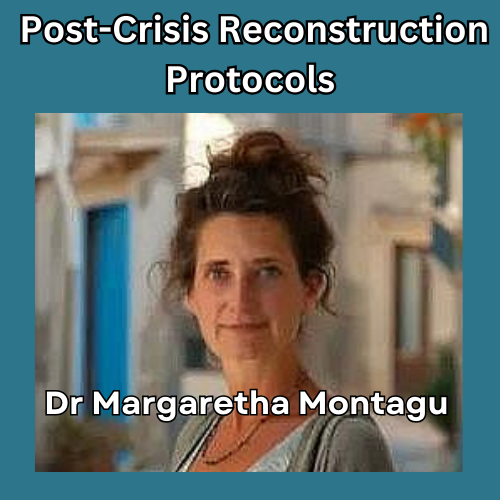Why Rebuilding after a Life Transition is a Better Investment than Starting Over
In the landscape of personal and professional development, we’ve been sold a seductive narrative: when life throws you a curveball, reinvent yourself. This mantra has become the gospel of countless self-help books, TED talks, and LinkedIn posts.
In certain situations, the only possible option might well be reinvention. But in the majority of others, reconstructing is the more intelligent choice. The path forward, in my experience, often isn’t about becoming someone new, but rather about reconstructing who you are.
However tempted by the idea of a “completely new me,” I chose reconstruction after I had to retire from medicine because of health problems. I could not suddenly stop being a doctor and become someone completely different. I chose to reconstruct, on the foundation I already had, and built a new life for myself.
The Reinvention Fallacy
“Reinvent yourself!” they say, as if your entire history, experience, and identity were disposable assets rather than your greatest resources. We’re encouraged to shed our old selves like a snake shedding its skin—clean, complete, dramatic.
The problem? We aren’t snakes.
When accomplished professionals face career transitions, relationship endings, or health challenges, the reinvention narrative suggests starting with a blank slate. But that is impossible: there is no blank slate. You are the sum of your experiences, skills, relationships, and insights—even the painful ones. Perhaps especially the painful ones.
Reinvention implies rejection. It asks us to discard who we’ve been in pursuit of who we want to be next. It creates an artificial dichotomy between our past and future selves that leaves us feeling fragmented rather than whole.
The Case for Reconstruction
Reconstruction acknowledges a fundamental truth that reinvention ignores: you already have the building blocks for your next chapter.
Think of it like this: Reinvention is demolishing a house to build something entirely different on the same plot. Reconstruction is assessing the structure, preserving what’s sound, replacing what’s damaged, and thoughtfully expanding where needed.
The distinction isn’t merely semantic—it’s transformative.
Reconstruction Honours Your Journey
When Sarah, a former CFO, experienced burnout after fifteen years in finance, well-meaning friends urged her to “reinvent herself completely.” Follow your passion! Do something creative! Start fresh!
Instead, Sarah chose reconstruction. Rather than discarding her financial expertise, she examined which elements of her work had energised rather than depleted her. She discovered she loved mentoring junior staff and translating complex concepts into accessible language. These weren’t skills to abandon, but foundations to build upon.
Today, Sarah runs a financial literacy program for underserved communities, drawing daily on her technical knowledge while expressing her values in new ways. She didn’t reinvent—she reconstructed, using existing strengths in service of new purposes.
Reconstruction Leverages Hard-Won Wisdom
Life transitions often arrive packaged with pain. Divorce, job loss, health crises—these experiences shape us profoundly. Reinvention says “move on.” Reconstruction says “integrate.”
When James lost his technology company after a decade of building it, he initially tried to reinvent himself in an entirely different field. But he found himself haunted by what felt like wasted experience. The reinvention approach required denying the validity and value of those ten entrepreneurial years.
Reconstruction offered a different path. By examining both the successes and failures of his company, James extracted invaluable lessons about leadership, innovation cycles, and his own relationship with risk. These insights became the foundation for his next venture—one built not despite his past, but because of it.
The Neuroscience Behind Reconstruction
Our resistance to the reinvention narrative isn’t just philosophical—it’s neurological. The brain doesn’t function by compartmentalising experiences. Instead, it creates intricate neural networks that connect new information with existing knowledge.
When we attempt reinvention, we’re fighting against our brain’s natural learning processes. We’re trying to bypass neural pathways rather than strengthen and redirect them. This creates internal conflict that manifests as anxiety, imposter syndrome, and decision paralysis.
Reconstruction, by contrast, works with your brain’s architecture. It acknowledges that meaningful change happens not by erasing what came before, but by building new connections from established neural foundations.
Practical Implementation: The Reconstruction Framework
So how do we practice reconstruction after significant life transitions? The process involves five key steps:
1. Archaeological Assessment
Begin by excavating your experience with curious detachment. What skills, relationships, and insights have you accumulated? What values have remained constant across different chapters of your life? What patterns emerge when you examine your successes and challenges?
This isn’t about crafting a highlight reel or focusing exclusively on credentials. It’s about honest inventory of your full resource library—including the “shadow skills” developed during difficult periods.
2. Structural Analysis
Next, determine which elements of your foundation remain solid and which require renovation. This means distinguishing between:
- Core strengths: Capabilities that remain relevant and energizing
- Transferable skills: Abilities that can be applied in new contexts
- Limiting patterns: Approaches that no longer serve you
- Knowledge gaps: Areas where new learning is required
Unlike reinvention, which might ignore existing strengths in pursuit of novelty, reconstruction identifies the load-bearing walls of your professional identity.
3. Mindful Demolition
Some aspects of your previous life may indeed need to be dismantled—but selectively, not wholesale. Perhaps certain relationships have become toxic, or specific habits undermine your wellbeing.
The key difference from reinvention? You’re removing specific elements with surgical precision, not bulldozing indiscriminately.
4. Intentional Integration
With clear understanding of your existing foundations, you can begin integrating new elements that align with your evolving vision. This might include:
- New skills that complement existing expertise
- Relationships that challenge and support your growth
- Experiences that broaden your perspective
- Tools that enhance your effectiveness
The focus is on coherence and complementarity, not contradiction.
5. Interactive Refinement
Reconstruction isn’t a one-time event but an ongoing process. As you build and occupy your new structure, you’ll discover what works and what doesn’t. The beauty of reconstruction is its flexibility—you can continue modifying the design without questioning the entire foundation.
When Reinvention Does Make Sense
To be fair, there are circumstances where aspects of reinvention become necessary. When core industries become obsolete or when fundamental values shift dramatically, more radical change may be required.
Even then, however, total reinvention remains largely mythical. The executives who successfully navigated from print media to digital platforms didn’t erase their understanding of editorial excellence or audience engagement—they applied these principles in new technological contexts.
The Courage of Continuity
Perhaps the most counterintuitive aspect of reconstruction is that it often requires more courage than reinvention. There’s a certain romantic appeal to dramatic fresh starts—they promise escape from past disappointments and identity constraints.
Reconstruction demands something harder: integration of your full story, including chapters you might prefer to skip. It requires acknowledging that your previous choices weren’t mistakes to be erased but experiences to be metabolised.
When Michael, a former high-powered attorney, faced a crisis of meaning mid-career, friends advised the classic reinvention playbook: quit, travel the world, “find yourself.” The cultural narrative celebrates these dramatic pivots.
Instead, Michael chose the quieter heroism of reconstruction. He examined which aspects of law had originally called to him—the intellectual challenge, the opportunity to protect vulnerable people, the structured approach to complex problems. He realised these elements still resonated, but the competitive law firm environment didn’t.
Today, Michael works as general counsel for a nonprofit advancing economic justice. His legal training remains central to his identity, but it now serves different ends in a different context. His reconstruction maintained continuity while enabling profound change.
The Lasting Impact of Reconstruction
The reconstruction approach delivers several advantages that reinvention cannot:
- Authentic integration of your full experience rather than compartmentalisation
- Accelerated adaptation by building on existing neural pathways
- Reduced identity friction and imposter syndrome
- Greater resilience through appreciation of your proven ability to evolve
- Deeper impact by applying established expertise to new challenges
Forward Integration
As we navigate increasingly complex career landscapes and personal transitions, the pressure to constantly reinvent ourselves will only intensify. The marketplace of ideas profits from our sense of inadequacy and our fear of irrelevance.
Reconstruction offers a more sustainable alternative—one that honours both who you’ve been and who you’re becoming. It transforms the narrative from one of disruptive reinvention to one of purposeful evolution.
The next time you face a significant transition, resist the cultural pressure to reinvent yourself. Instead, approach the challenge as a master builder surveying a structure with good bones but new potential. Your next chapter doesn’t require becoming someone else—it calls for becoming more fully yourself.
Your history isn’t baggage to discard. It’s your most valuable building material.
When life as you knew it falls apart, the pressure to “reinvent yourself” can feel overwhelming. The Post-Crisis Reconstruction Protocols™ offer a radically different alternative—helping you reconstruct rather than reinvent. Instead of discarding your past or forcing a shiny new persona, this medically-informed, soul-strengthening roadmap guides you to rebuild from the inside out. We will honour your story, sift through the rubble for what’s still true, and help you reassemble your identity with clarity, confidence, and purpose. It’s not about becoming someone else—it’s about becoming whole again.
To find out more, email me at OpenLockedDoors@gmail.com.

Ready to start again, stronger than ever before? This quiz will help you find out. It is not just about measuring where you are right now; it’s about shining a light on the areas of your life that feel meaningful, as well as those that might need attention. It’s an opportunity to reflect, recalibrate, and take steps toward a life that’s not only successful but profoundly fulfilling. Take The Quiz

“I am an experienced medical doctor – MBChB, MRCGP, NLP master pract cert, Transformational Life Coach (dip.) Life Story Coach (cert.) Counselling (cert.) Med Hypnotherapy (dip.) and EAGALA (cert.) I may have an impressive number of letters after my name, and more than three decades of professional experience, but what qualifies me to excel at what I do is my intuitive understanding of my clients’ difficulties and my extensive personal experience of managing major life changes using strategies I developed over many years” Dr M Montagu

